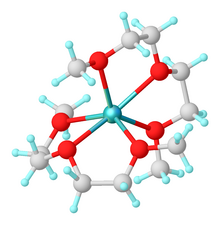Diglyme

| |
| Names | |
|---|---|
| Preferred IUPAC name
1-Methoxy-2-(2-methoxyethoxy)ethane[1] | |
| Other names
Diglyme
2-Methoxyethyl ether Di(2-methoxyethyl) ether Diethylene glycol dimethyl ether | |
| Identifiers | |
3D model (JSmol)
|
|
| ChEBI | |
| ChemSpider | |
| DrugBank | |
| ECHA InfoCard | 100.003.568 |
| EC Number |
|
PubChem CID
|
|
| UNII | |
CompTox Dashboard (EPA)
|
|
| |
| |
| Properties | |
| C6H14O3 | |
| Molar mass | 134.175 g·mol−1 |
| Density | 0.937 g/mL |
| Melting point | −64 °C (−83 °F; 209 K) |
| Boiling point | 162 °C (324 °F; 435 K) |
| miscible | |
| Hazards | |
| Flash point | 57 °C (135 °F; 330 K) |
| Related compounds | |
Related compounds
|
Diethylene glycol diethyl ether, ethylene glycol dimethyl ether |
Except where otherwise noted, data are given for materials in their standard state (at 25 °C [77 °F], 100 kPa).
| |
Diglyme, or bis(2-methoxyethyl) ether, is a solvent with a high boiling point. It is an organic compound which is the dimethyl ether of diethylene glycol. (The name "diglyme" is a portmanteau of "diglycol methyl ether.") It is a colorless liquid with a slight ether-like odor. It is miscible with water as well as organic solvents.
It is prepared by a reaction of dimethyl ether and ethylene oxide over an acid catalyst.[2]
Solvent

Because of its resiliance to strong bases, diglyme is favored as a solvent for reactions of alkali metal reagents even at high temperatures. Rate enhancements in reactions involving organometallic reagents, such as Grignard reactions or metal hydride reductions, have been observed when using diglyme as a solvent.[4][5]
Diglyme is also used as a solvent in hydroboration reactions with diborane.[6][7]
It serves as a chelate for alkali metal cations, leaving anions more active.
Safety
The European Chemicals Agency lists diglyme as a Substances of Very High Concern (SVHC) as a Reproductive Toxin.[8]
References
- ^ Nomenclature of Organic Chemistry : IUPAC Recommendations and Preferred Names 2013 (Blue Book). Cambridge: The Royal Society of Chemistry. 2014. p. 704. doi:10.1039/9781849733069-FP001. ISBN 978-0-85404-182-4.
- ^ Siegfried Rebsdat; Dieter Mayer. "Ethylene Glycol". Ullmann's Encyclopedia of Industrial Chemistry. Weinheim: Wiley-VCH. doi:10.1002/14356007.a10_101. ISBN 978-3527306732.
- ^ "Novel Fluorenyl Alkali Metal DIGLYME Complexes: Synthesis and Solid State Structures". J. Organomet. Chem. 656 (1–2): 89. 2002. doi:10.1016/S0022-328X(02)01563-2.
{{cite journal}}: Unknown parameter|authors=ignored (help) - ^ "Tris[Bis(2-Methoxyethyl)Ether]Potassium and Tetraphenylarsonium Hexacarbonylmetallates(1-) of Niobium and Tantalum". Tris[Bis(2-Methoxyethyl)Ether]Potassium and Tetraphenylarsonium Hexacarbonylmetallates(1–) of Niobium and Tantalum. Inorganic Syntheses. Vol. 16. 1976. pp. 68–73. doi:10.1002/9780470132470.ch21. ISBN 9780470132470.
{{cite book}}:|journal=ignored (help); Unknown parameter|authors=ignored (help) - ^ "3,5-Dinitrobenzaldehyde". Organic Syntheses. 53: 52. 1973. doi:10.15227/orgsyn.053.0052.
{{cite journal}}: Unknown parameter|authors=ignored (help) - ^ "Boranes in Functionalization of Olefins to Amines: 3-Pinanamine". Organic Syntheses. 58: 32. 1978. doi:10.15227/orgsyn.058.0032.
{{cite journal}}: Unknown parameter|authors=ignored (help) - ^ "Perhydro-9b-Boraphenalene and Perhydro-9b-Phenalenol". Organic Syntheses. 61: 103. 1983. doi:10.15227/orgsyn.061.0103.
{{cite journal}}: Unknown parameter|authors=ignored (help) - ^ "Inclusion of Substances of Very High Concern in the Candidate List (Decision of the European Chemicals Agency)". 19 Dec 2011.
